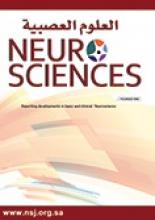Research ArticleOriginal Article
Open Access
Assessment of demographic and clinical characteristics on functional status and disability of patients with stroke
Derya Memis, Erkan Kozanoglu, Bayram Kelle and Mustafa K. Goncu
Neurosciences Journal October 2016, 21 (4) 352-357; DOI: https://doi.org/10.17712/nsj.2016.4.20160212
Derya Memis
From the Department of Physical Medicine and Rehabilitation (Memis), Adana Numune Education and Research Hospital, and the Department of Physical Medicine and Rehabilitation (Kozanoglu, Kelle, Goncu), Faculty of Medicine, Cukurova University, Adana, Turkey
MDErkan Kozanoglu
From the Department of Physical Medicine and Rehabilitation (Memis), Adana Numune Education and Research Hospital, and the Department of Physical Medicine and Rehabilitation (Kozanoglu, Kelle, Goncu), Faculty of Medicine, Cukurova University, Adana, Turkey
MDBayram Kelle
From the Department of Physical Medicine and Rehabilitation (Memis), Adana Numune Education and Research Hospital, and the Department of Physical Medicine and Rehabilitation (Kozanoglu, Kelle, Goncu), Faculty of Medicine, Cukurova University, Adana, Turkey
MDMustafa K. Goncu
From the Department of Physical Medicine and Rehabilitation (Memis), Adana Numune Education and Research Hospital, and the Department of Physical Medicine and Rehabilitation (Kozanoglu, Kelle, Goncu), Faculty of Medicine, Cukurova University, Adana, Turkey
MD
References
- ↵
- Geroin C,
- Mazzoleni S,
- Smania N,
- Gandolfi M,
- Bonaiuti D,
- Gasperini G,
- et al.
- ↵
- Gunaydin R,
- Karatepe AG,
- Kaya T,
- Ulutas O
- ↵
- Patel MD,
- Tilling K,
- Lawrence E,
- Rudd AG,
- Wolfe CD,
- McKevitt C
- ↵
- Milinavičienė E,
- Rastenytė D,
- Kriščiūnas A
- ↵
- Cioncoloni D,
- Piu P,
- Tassi R,
- Acampa M,
- Guideri F,
- Taddei S,
- et al.
- ↵
- Feigin VL,
- Wiebers DO,
- Nikitin YP,
- O’Fallon WM,
- Whisnant JP
- ↵
- Sun H,
- Zou X,
- Liu L
- ↵
- Bagg S,
- Pombo AP,
- Hopman W
- ↵
- Brunnström S
- ↵
- Ashworth B
- ↵
- Bohannon RW,
- Smith MB
- ↵
- Holden MK,
- Gill KM,
- Magliozzi M,
- Nathan J,
- Piehl-Baker L
- ↵
- Mahoney FI,
- Barthel DW
- Shah S,
- Vanclay F,
- Cooper B
- ↵
- Küçükdeveci AA,
- Yavuzer G,
- Tennant BA,
- Süldür N,
- Sonel B,
- Arasıl T
- ↵
- van Swieten JC,
- Koudstaal PJ,
- Visser MC,
- Schouten HJ,
- van Gijn J
- ↵
- Banks JL,
- Marotta CA
- ↵
- Collen FM,
- Wade DT,
- Robb GF,
- Bradshaw CM
- ↵
- Sacco RL,
- Benjamin EJ,
- Broderick JP,
- Dyken M,
- Easton JD,
- Feinberg WM,
- et al.
- ↵
- Sacco RL,
- Wolf PA,
- Gorelick PB
- ↵
- Cabral NL,
- Gonçalves AR,
- Longo AL,
- Moro CH,
- Costa G,
- Amaral CH,
- et al.
- ↵
- Arboix A,
- Cendrós V,
- Besa M,
- Garcia-Eroles L,
- Oliveras M,
- Tarqa C,
- et al.
- ↵
- Dogan A,
- Nakipoglu GF,
- Aslan DM,
- Kaya ZA,
- Özgirgin N
- ↵
- Zhang LF,
- Yang J,
- Hong Z,
- Yuan GG,
- Zhou BF,
- Zhao LC,
- et al.
- ↵
- Arboix A,
- García-Eroles L,
- Massons J,
- Oliveres M,
- Targa C
- ↵
- Wang Y,
- Lim LL,
- Heler RF,
- Fisher J,
- Levi CR
- ↵
- Uyttenboogaart M,
- Luijckx GJ,
- Vroomen PC,
- Stewart RE,
- De Keyser J
- ↵
- Chou K,
- Lee G
- ↵
- Arboix A,
- Padilla I,
- Massons J,
- García-Eroles L,
- Comes E,
- Targa C
- ↵
- Morone G,
- Iosa M,
- Bragoni M,
- De Angelis D,
- Venturiero V,
- Coiro P,
- et al.
- ↵
- Dias D,
- Laíns J,
- Pereira A,
- Nunes R,
- Caldas J,
- Amaral C,
- et al.
- ↵
- Eser F,
- Yavuzer G,
- Karakus D,
- Karaoglan B
In this issue
Assessment of demographic and clinical characteristics on functional status and disability of patients with stroke
Derya Memis, Erkan Kozanoglu, Bayram Kelle, Mustafa K. Goncu
Neurosciences Journal Oct 2016, 21 (4) 352-357; DOI: 10.17712/nsj.2016.4.20160212
Jump to section
Related Articles
- No related articles found.
Cited By...
- No citing articles found.





